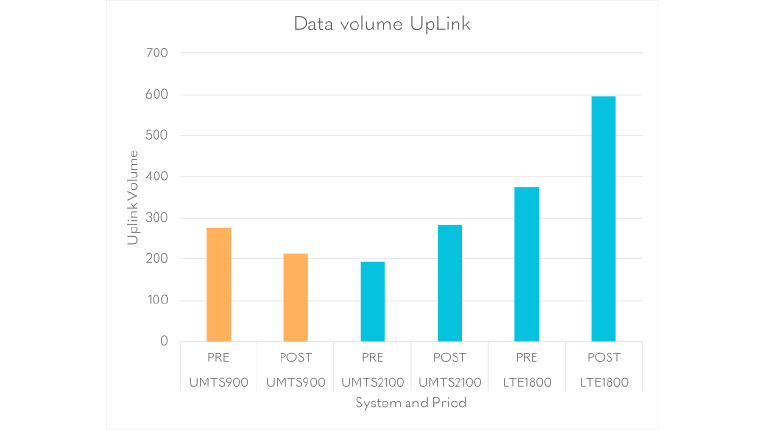Rural coverage: Offloading
from the congested low band
Cellmax antennas improved high-band coverage, decreasing congestion on the low band and allowing full utilization of the high band’s vast capacity.
A carrier experiencing a congested low band in rural Scandinavia wanted to see if it could offload low band to the high band, where there was much more capacity, just by changing the antenna to a CellMax high-gain antenna.
The implementation carried out at three sites, with three antennas per site. KPIs were compared for a period of 10 days before and 10 days after the antennas were changed.
The Drive Tests, Pre and Post, were compared on a GPS bin to GPS bin comparison, with one bin per GPS location. This minimized the risk of collecting a disproportionate amount of data in one location, when stopped at a red traffic light, for example, or due to differences in drive routes.
“Before we replaced the antennas, we mapped out the corresponding tilts to provide the same best server area as the existing antennas,” explains Hammad Abuiseifan, Cellmax CEO.
100% quality improvement
On the LTE 1800 band, the average RSRP improvement was +2.4 dB, with an improvement of 3 – 3.5 dB where the signal was low. For 99% of the area, there was an average 3dB (100%) improvement all the way out to the cell edge 3–7 km away.
The increase in signal level also increased signal quality, with an average CINR improvement of +1.4 dB. Where the signal had been low, the improvement was even greater – between 3 and 5 dB with the CellMax antennas.
At the cell edge, which the carrier defined as below –116 dBm, the improvement was even greater. Average RSRP improved by +3.2 dB (+108%) and CINR by +3.0 dB (100%). This enables a better modulation coding scheme, which corresponds to a 68% improvement in network efficiency with CellMax, as speed increases from 0.9 (bits/second/Hertz) to 1.5 (bits/second/Hertz).
This improvement allows the carrier to add more traffic, more users and higher throughput. This is especially important for users on the cell edge, since they cost a lot in capacity. They have a certain amount of data that they want, but if they get it at a slow pace, carriers cannot just push the data out and release capacity for other users. Essentially, the network is congested by slow users trying to get data from the system.
Data speed increase of 32%
The test had a major impact on all key performance indicators. For LTE 1800, downlink volume was up by 53%, with download speed up by 14%. For uplink, volume increased by 59% and speed by 32%. Connected devices increased by 36%. Perhaps most noticeable to users, the drop rate for phone calls decreased by 87%.
For the low-band network, downlink data volume increased by 40%, while uplink data volume increased by 47%. Voice calls increased by a massive 75% on the high band, while dropping by 22% on the untouched low band, a significant decrease in congestion. Taken together, it is evident that overall voice traffic is up because the network had been too congested to take all the calls people wanted to make. Users who could not use the congested low band and could not use the higher frequency band because they were so far out, could get on the network.
The same pattern was achieved for data, with data load going down on the low band but up much, much more in the high band. “This is an effect of a better network, because when people have a good network they use it,” Abuiseifan observes. “This corresponds to more subscribers or the purchase of more data buckets, or both.”

Major impact on KPIs: For LTE 1800, downlink volume was up by 53%, with download speed up by 14%. For uplink, volume increased by 59% and speed by 32%. Connected devices increased by 36%. For the UMTS 2100 network, downlink data volume increased by 40%, while uplink data volume increased by 47%. Voice calls also increased by a massive 75%, while dropping by 22% on the untouched low band, a significant decrease in congestion.
Improved KPIs
Although the data load on LTE 2600 increased in both the reference and the text clusters, it increased by twice as much in the CellMax cluster (22% vs 44%).
“This is directly related to improved indoor coverage,” Abuiseifan says. “The lowest detected signal outdoors in the drive test was -105 dBm. Redirects only occur when the level drops to –122 dBm. That extra loss occurs indoors.”
38% fewer redirects
As a result, while the redirect rate in the reference cluster was virtually unchanged, in the test area, the figure dropped by 38%. This means that more data sessions were maintained, instead of being pushed down to the slower network. In short, the subscribers could enjoy the larger 2600 LTE spectrum deeper inside the buildings and stay longer on it.
“From a subscriber satisfaction perspective, you want to keep your subscribers on the more advanced technology,” Abuiseifan points out. “On 2600 LTE, the carrier also had much more capacity, but it could not be used indoors before the change to CellMax. And the improvement also led to 29% fewer dropped calls.
“This shows that there are great network gains to be achieved when changing to CellMax High-Efficiency antennas in a dense, urban network.”
Customer cases
Real-world success stories
Contact
We’d love to hear from you!
Feel free to call us or send us a message.